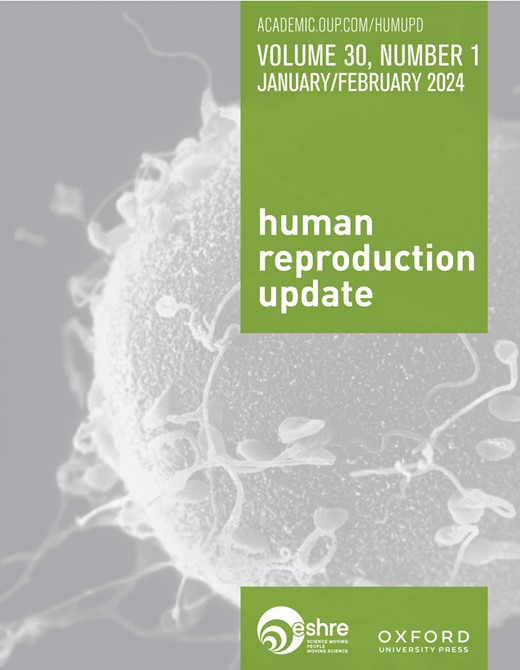人类着床前胚胎的转录谱分析和基因调控:亲代效应和ARTs的影响
IF 16.1
1区 医学
Q1 OBSTETRICS & GYNECOLOGY
引用次数: 0
摘要
不孕不育是一个日益严峻的全球性挑战,抗逆转录病毒疗法显著提高了不孕夫妇的出生率。然而,抗逆转录病毒治疗与产科和围产期不良结局的高风险相关,对后代健康有潜在的长期影响。许多着床前胚胎表现为形态动力学异常、着床失败或发育受阻。ART程序和亲本因素被怀疑扰乱了胚胎转录组,可能影响配子体发生和早期发育过程中的分子和表观遗传事件。这些扰动的时间和机制尚不清楚。在ART受孕的人类着床前胚胎中全基因组转录组失调可能为观察到的ART与自然受孕后代之间的差异提供重要见解。目的和原理本综述旨在探讨人类着床前胚胎的转录组如何受到亲代特征、ART条件和胚胎因素的影响,并以囊胚期获得谱系特异性标记物的时间序列为前提。主要目的是汇编由亲代和内在特征或art特异性干预引起的基因表达变化。第二个目的是在所有研究的因素中确定共同的失调分子途径。检索方法一项全面的PubMed检索(截至2024年12月)进行,以确定评估人类囊胚转录组谱的研究。研究纳入基于父母不孕特征(如年龄、多囊卵巢综合征(PCOS)、子宫内膜异位症、卵巢储备减少(DOR)、精子改变、不明原因不孕(UI)和肥胖)、ART干预(如激素刺激、IVM、IVF、培养条件和玻璃化)和胚胎内在因素(如形态、倍性、性别和发育停止)的研究。不同胚胎组之间的差异表达基因在研究中进行比较,基因本体分析确定了共同或特定的途径。单细胞RNA测序数据用于绘制人类囊胚谱系特异性转录组模式,按细胞系(外胚层、原始内胚层和滋养外胚层)对表达变化进行分类。在囊胚的人类数据有限的地方,讨论了动物研究或其他分裂阶段。结果:母亲年龄是人类囊胚中基因表达失调的最重要因素,影响代谢和发育过程。培养基的变化影响细胞周期调节、碳水化合物代谢和RNA生物合成。囊胚形态主要影响代谢过程的变化。胚泡非整倍性诱导了外胚层发育途径和多能性基因表达的显著变化。关于PCOS、子宫内膜异位症、DOR、精子改变、UI和ART技术影响的证据仍然有限。失调的通路通常涉及代谢、细胞、生殖和发育过程。基因组印迹和染色质修饰基因的失调也在至少两种情况下被观察到。本综述强调了人类着床前胚胎中基因表达的复杂性,包括父母年龄、ART条件、发育阶段和胚胎性别等多种影响。ART程序可能对囊胚转录组具有累积效应。可改变的因素,如培养条件,为改善体外受精结果提供了机会。表观遗传修饰也可能对这些不同的影响敏感,并参与观察到的转录组变化,从而开启进一步的研究调查,以阐明长期健康影响。注册号码n/a。本文章由计算机程序翻译,如有差异,请以英文原文为准。
Transcript profiling and gene regulation of the human pre-implantation embryo: parental effects and impact of ARTs
BACKGROUND Infertility is a growing global challenge, with ARTs significantly improving birth rates for infertile couples. However, ART conceptions are associated with a higher risk of negative obstetrical and perinatal outcomes, with potential long-term effects on offspring health. Many pre-implantation embryos exhibit abnormal morphokinetics, implantation failure, or arrested development. ART procedures and parental factors are suspected to perturb the embryonic transcriptome, potentially affecting molecular and epigenetic events during gametogenesis and early development. The timing and mechanisms of these perturbations remain unclear. Genome-wide transcriptomic misregulation in ART-conceived human pre-implantation embryos may provide important insights into observed differences between ART and naturally conceived offspring. OBJECTIVE AND RATIONALE This narrative review aims to explore how the transcriptome of the human pre-implantation embryo is influenced by parental characteristics, ART conditions, and embryonic factors, with the characterization of the temporal sequence of acquisition of lineage-specific markers at the blastocyst stage serving as a prerequisite. The primary objective is to compile changes in gene expression resulting from parental and intrinsic characteristics or from ART-specific interventions. A secondary aim is to identify common dysregulated molecular pathways across all factors studied. SEARCH METHODS A comprehensive PubMed search (up to December 2024) was conducted to identify studies assessing transcriptomic profiles in human blastocysts. Studies were included based on parental infertility characteristics (e.g. age, polycystic ovary syndrome (PCOS), endometriosis, diminished ovarian reserve (DOR), sperm alterations, unexplained infertility (UI), and obesity), ART interventions (e.g. hormonal stimulation, IVM, IVF, culture conditions, and vitrification), and intrinsic embryo factors (e.g. morphology, ploidy, sex, and developmental arrest). Differentially expressed genes between different embryo groups were compared across studies, and Gene Ontology analysis identified common or specific pathways. Single-cell RNA sequencing data were used to map lineage-specific transcriptomic patterns in human blastocysts, categorizing expression changes by cell lineages (epiblast, primitive endoderm, and trophectoderm). Where human data on blastocysts were limited, animal studies or other cleaved stages were discussed. OUTCOMES Maternal age was the most significant contributor to misregulated gene expression in human blastocysts, affecting metabolic and developmental processes. Variations in culture medium impacted cell cycle regulation, carbohydrate metabolism, and RNA biosynthesis. Blastocyst morphology mostly influenced metabolic process changes. Blastocyst aneuploidy induced significant changes in developmental pathways and pluripotency gene expression in the epiblast. Evidence on the effects of PCOS, endometriosis, DOR, sperm alterations, UI, and ART technologies remains limited. Dysregulated pathways commonly involve metabolic, cellular, reproductive, and developmental processes. Dysregulation of genomic imprinting and chromatin-modifier genes was also observed across at least two conditions. WIDER IMPLICATIONS This review highlights the complexity of interpreting gene expression in human pre-implantation embryos due to diverse influences, including parental age, ART conditions, developmental stage, and embryo sex. ART procedures may have cumulative effects on the blastocyst transcriptome. Modifiable factors, such as culture conditions, offer opportunities for improving IVF outcomes. Epigenetic modifications may also be sensitive to these diverse influences and involved in observed transcriptomic changes, opening further research investigation to clarify long-term health effects. REGISTRATION NUMBER n/a.
求助全文
通过发布文献求助,成功后即可免费获取论文全文。
去求助
来源期刊

Human Reproduction Update
医学-妇产科学
CiteScore
28.80
自引率
1.50%
发文量
38
期刊介绍:
Human Reproduction Update is the leading journal in its field, boasting a Journal Impact FactorTM of 13.3 and ranked first in Obstetrics & Gynecology and Reproductive Biology (Source: Journal Citation ReportsTM from Clarivate, 2023). It specializes in publishing comprehensive and systematic review articles covering various aspects of human reproductive physiology and medicine.
The journal prioritizes basic, transitional, and clinical topics related to reproduction, encompassing areas such as andrology, embryology, infertility, gynaecology, pregnancy, reproductive endocrinology, reproductive epidemiology, reproductive genetics, reproductive immunology, and reproductive oncology. Human Reproduction Update is published on behalf of the European Society of Human Reproduction and Embryology (ESHRE), maintaining the highest scientific and editorial standards.
 求助内容:
求助内容: 应助结果提醒方式:
应助结果提醒方式:


